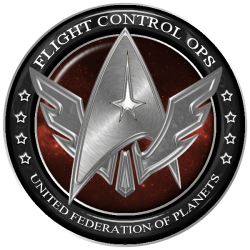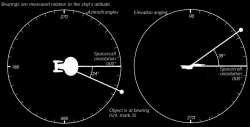CONN
From Star Trek: Theurgy Wiki
Flight Control Operations, or CONN for short, was the ship's helm department, which was in charge of handling all flight operations on and off the ship. This meant the Theurgy and all of its support vehicles or any vehicles flying within its vicinity. Instead of the Tactical CONN department flying fighters, the CONN officers operated the shuttles.
Mission Status
This segment describes the current situation aboard the Theurgy.
UNDER CONSTRUCTION
Standard Duties
The officer at the Flight Control console on the bridge of a starship, often referred to as CONN, was responsible for the actual piloting and navigation of the spacecraft. Although these were heavily automated functions, their criticality demanded a human officer to oversee these operations at all times. The Flight Control Officer (also referred to as CONN or helmsman) received instructions directly from the Commanding Officer. An officer's ability at the CONN covered piloting craft of all sizes, from ground vehicles and shuttles, to grand starships. It also included expertise in all navigation — both on the ground and in space. They had to be able to direct a starship or other vessel through a difficult environment, or to operate a craft with such precision as to aid someone else’s activities. They had to direct a starship or other vessel to avoid a sudden and imminent danger, or to perform extreme or unorthodox maneuvers with a craft using “feel” or “instinct”. They also had to be quick and effective in getting into an EVA suit, including moving through zero-gravity, or resisting the deleterious effects of extreme acceleration or unpredictable motion without an Inertial Dampening Field.
These officers were also experts in judging the nature or intent of another vessel by the way it is moving, or determining the source of a problem with a familiar vessel. They also had to maintain professional decorum and etiquette when representing your ship or Starfleet in formal circumstances, or to argue effectively over a matter of starship protocol, or a course of action.
There were five major areas of responsibility for the Flight Control Officer:
- Navigational references/course plotting
- Supervision of automatic flight operations
- Manual flight operations
- Position verification
- Bridge liaison to the engineering department
During impulse powered spaceflight, the helmsman was responsible for monitoring relativistic effects as well as inertial damping system status. In the event that a requested maneuver exceeded the capacity of the inertial damping system, the computer will request CONN officer to modify the flight plan to bring it within the permitted performance envelope. During Alert status, flight rules permitted the helmsman to specify maneuvers that are potentially dangerous to the crew or the spacecraft. Warp flight operating rules required the CONN officer to monitor subspace field geometry in parallel with the Engineering department. During warp flight, the Flight Control console continually updated long-range sensor data and makes automatic course corrections to adjust for minor variations in the density of the interstellar medium.
Because of the criticality of Flight Control in spacecraft operations, particularly during crisis situations, Conn is connected to a dedicated backup flight operations subprocessor to provide for manual flight control. This equipment package includes emergency navigation sensors.
Positions
As of 2381, these were the different roles in this department:
| CONN Roles | |
|---|---|
| Role | Description |
| Chief CONN Officer |
Originally known as helm, or Flight Control Officer, CONN incorporated both navigation and flight control. A Flight Control Officer must always be present on the bridge of a starship. S/he ploted courses, supervised the computers piloting, corrected any flight deviations and piloted the ship manually when needed. The Chief Flight Control Officer was the senior most CONN Officer aboard, serving as a Senior Officer, and superior officer of the personnel under him/her. |
| Asst. Chief CONN Officer |
The Assist. Chief Flight Control Officer was the second senior-most CONN Officer aboard and reported directly to the Chief Flight Control Officer. On the Theurgy, there were two Asst. Chiefs because of the ship's MVAM capability. In the event that the ship had to separate for a longer duration, the Asst. Chief CONN Officers would serve as Chiefs on their own hull sections respectively. |
| Shuttlebay Manager |
The Shuttlebay Manager was responsible for pre and post-flight checks of all support craft involved in away missions. Once a support craft had been brought to the flight line, it was his/her duty to ensure that it was mission capable. Upon returning from a mission, he/she inspected the support craft and prepare a report on any maintenance required. He/she was also responsible for the placement of support craft in order to allow for maximum efficiency of the shuttlebay.
The Theurgy had two bays, the Upper and Lower Shuttle Bays, both having their own manager. The Fighter Assault Bay - where the warp fighters were housed - was under the purview of both the Chief of the Deck in Operations, as well as the Squadron Commanding Officer in Tactical CONN. |
| Flight Control Officer |
CONN Officers reported to the Chief CONN Officer and Asst. Chief CONN Officer. They were qualified to fly starships and acted as relief officers for the Chief and Asst. Chiefs on the bridge. |
| Chief Support Craft Pilot |
All small spacecrafts aboard a starship, starbase or a facility, like shuttles, runabouts, transports, the captain's yacht, patrol vessels, etc. - but excluding warp fighters - were flown by support craft pilots. This was often the proving ground for pilots until they earn a berth on a starship as a Flight Control Officer. The Chief Support Craft Pilot reported to the Chief CONN Officer and Asst. Chief CONN Officer. |
| Support Craft Pilot |
The Support Craft Pilot reported to the Chief Support Craft Pilot, and those who held this rank were usually low ranking Enlisted personnel. |
Specific Duties
- Navigational References/Course Plotting The Flight Control console displayed readings from navigational and tactical sensors, overlaying them on current positional and course projections. Conn has the option of accessing data feeds from secondary navigation and science sensors for verification of primary sensor data. Such cross-checks were automatically performed at each change-of-shift and upon activation of Alert status.
- Manual Flight Operations The actual execution of flight instructions was generally left to computer control, but CONN had the option of exercising manual control over the helm and navigational functions. In full manual mode, CONN can actually steer the ship under keypad control.
- Shuttle Operations The Chief CONN Officer would work very closely with the ship's Chief Operations Officer with respect to the use of the ship's shuttle bays since the Chief CONN Officer was responsible for the pilots flying the shuttles and for training shuttle pilots. Instead of Fighter Bay Ops handling the fighters, the regular Operations personnel - that answered to the Chief Operations Officer - handled the upkeep of the shuttles. Fighter Bay Ops belonged to the Operations department too, they were just specialized at warp fighters, but could be rotated to handle shuttles as well as required.
- Reaction Control System (RCS) Although the actual vector and sequence control of the system was normally automated, CONN had the option of manually commanding the RCS system or individual thrusters.
Bearing & Coordinates
There were five standard input modes available for specification of spacecraft flight paths. Any of these options may be entered either by keyboard or by vocal command. In each case, flight control software would automatically determine an optimal flight path conforming to Starfleet flight and safety protocol. The helm then had the option of executing this flight plan or modifying any parameters to meet specific mission needs.
Normal input modes included:
- Destination planet or stared system Any celestial object within the navigational database was acceptable as a destination, although the system would inform the helmsman in the event that a destination exceeded the operating range of the spacecraft. Specific facilities (such as orbital space stations) within the database were also acceptable destinations.
- Destination sector A sector identification number or sector common name was a valid destination. In the absence of a specific destination within a sector, the flight path would default to the geometric center of the specified sector.
- Spacecraft intercept This requires CONN to specify a target spacecraft on which a tactical sensor locked had been established. This also requires CONN to specify either a relative closing speed or an intercept time so that a speed could be determined. An absolute warp velocity could also be specified. Navigational software would determine an optimal flight path based on specified speed and tactical projection of target vehicle's flight path. Several variations of this mode were available for used during combat situations.
- Relative bearing A flight vector could be specified as an azimuth/elevation relative to the current orientation of the spacecraft. In such cases, 000-mark-0 represents a flight vector straight ahead.
- Absolute heading A flight vector could also be specified as an azimuth/elevation relative to the center of the Milky Way. In such cases, 000-mark-0 represents a flight vector from the ship to the center of the galaxy.
- Galactic coordinates Standard galactic XYZ coordinates were also acceptable as a valid input, although most starfleet personnel generally found this cumbersome.


